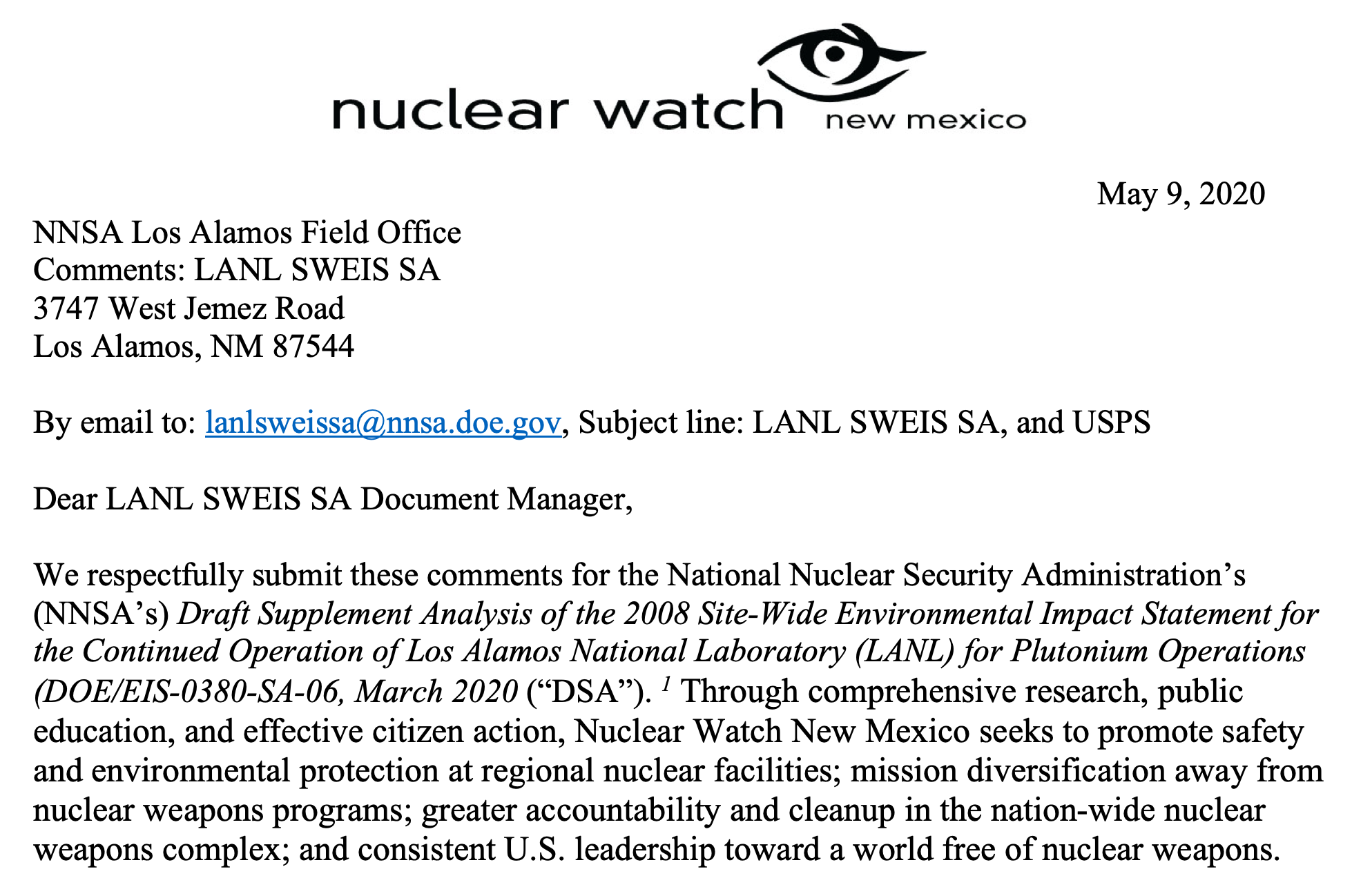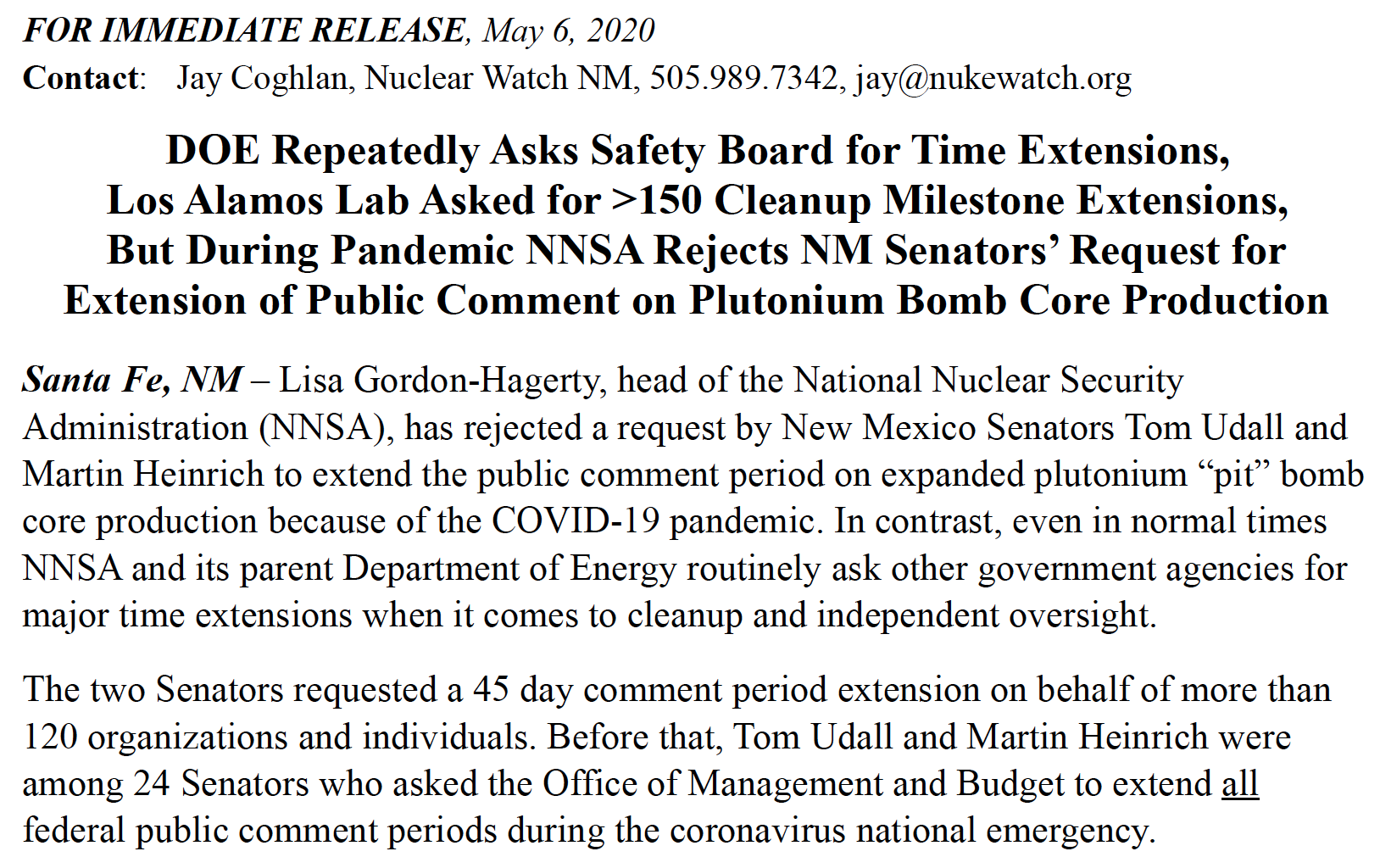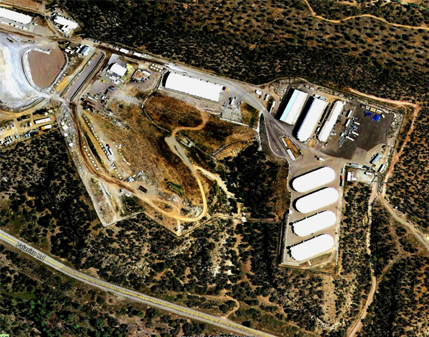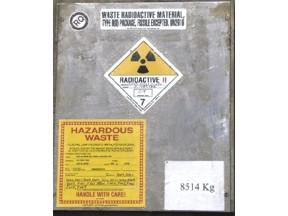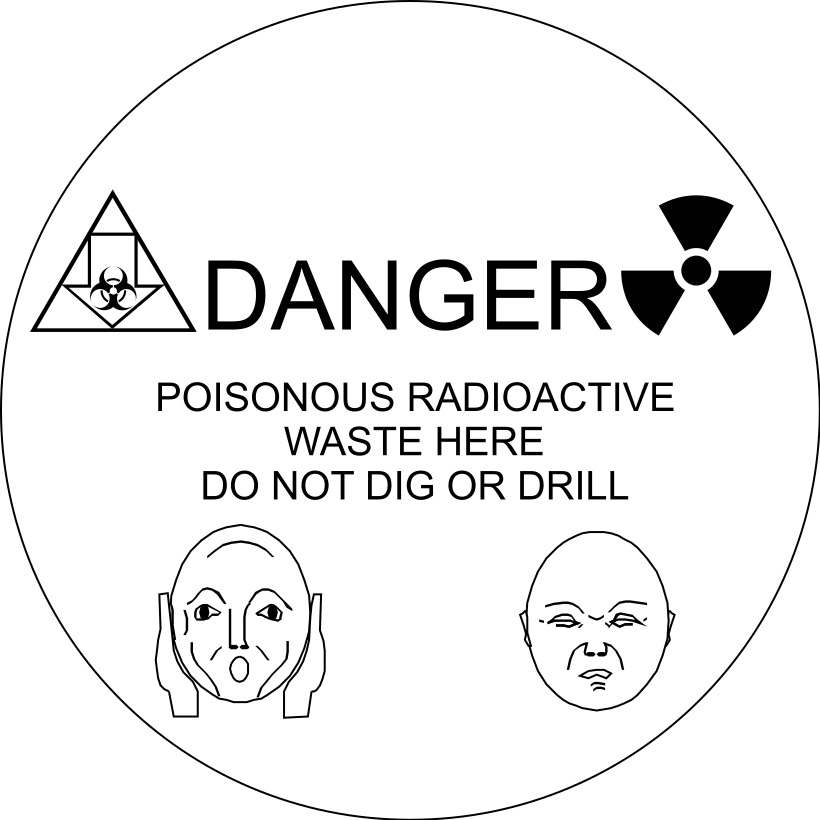2020
Trump Admin Sprints to Weaken Environmental Protections During Pandemic
‘There’s a lot they want to get done before the election, just in case.’

The Trump administration is diligently weakening U.S. environment protections even amid a global pandemic, continuing its rollback as the November election approaches.
During the COVID-19 lockdown, U.S. federal agencies have eased fuel-efficiency standards for new cars; frozen rules for soot air pollution; proposed to drop review requirements for liquefied natural gas terminals; continued to lease public property to oil and gas companies; sought to speed up permitting for offshore fish farms; and advanced a proposal on mercury pollution from power plants that could make it easier for the government to conclude regulations are too costly to justify their benefits.
Pit Production Must ‘Press Forward’ Despite Coronavirus Pandemic, NNSA Chief Says
Preparations and planning for plutonium pit production must continue amid the novel coronavirus pandemic, a “difficult” and challenging time, National Nuclear Security Administration chief Lisa Gordon-Hagerty wrote in a recent letter.
“The plutonium pit production mission is one of our highest national security priorities and is being done in accordance with congressional direction,” Gordon-Hagerty wrote to U.S. Sen. Tom Udall, a New Mexico Democrat. “We must press forward with this project in order to meet Department of Defense deliverables.”
Udall and U.S. Sen. Martin Heinrich, another New Mexico Democrat, in late April wrote to the National Nuclear Security Administration, asking the weapons-and-nonproliferation agency to extend a public comment period tied to plutonium pit production at Los Alamos National Laboratory, near Albuquerque and Santa Fe.
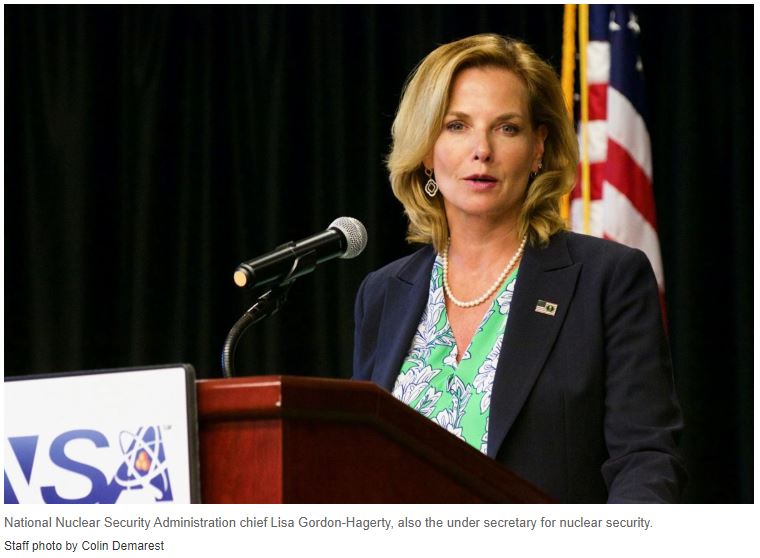
Gordon-Hagerty in her April 30 response said she appreciated the “interest in this matter” and that she takes the “concerns very seriously.”
Moving Forward With the W93 SLBM Warhead Strengthens U.S. and British Security
In his 2009 Prague speech, President Obama declared that “As long as [nuclear]weapons exist, the United States will maintain a safe, secure and effective arsenal to deter any adversary, and guarantee that defense to our allies.” To ensure that goal, he advanced a modernization program for America’s aging nuclear forces. President Trump, in his 2018 review of U.S. nuclear posture, reaffirmed that commitment and carried forward the program for force modernization that now will include a new program for a modern SLBM warhead—the so-called W93 to be carried in a new Mark 7 reentry vehicle.

The requirement to maintain a safe, secure and effective arsenal is often taken to mean the replacement of America’s aging strategic triad forces and their command and control. That effort, while truly vital, is only half what is needed.
Bulging Deficits May Threaten Prized Pentagon Arms Projects
WASHINGTON — The government’s $3 trillion effort to rescue the economy from the coronavirus crisis is stirring worry at the Pentagon. Bulging federal deficits may force a reversal of years of big defense spending gains and threaten prized projects like the rebuilding of the nation’s arsenal of nuclear weapons.
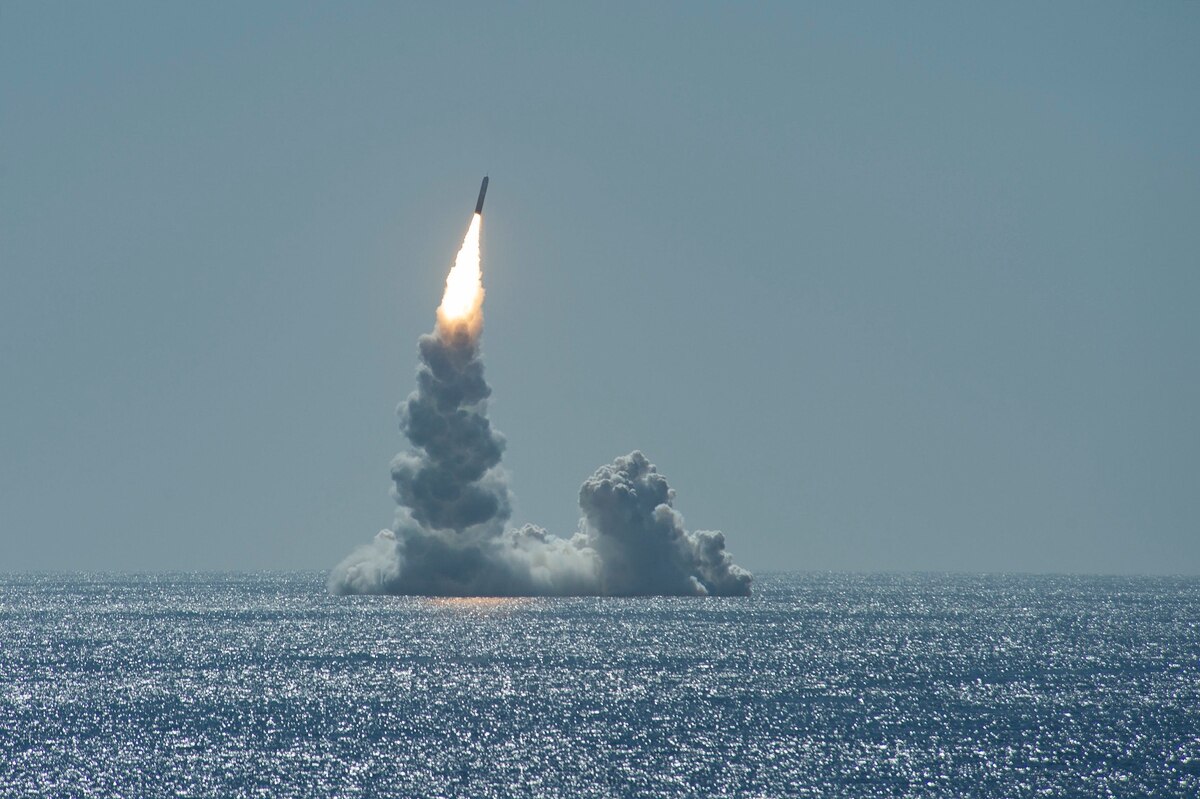
Defense Secretary Mark Esper says the sudden burst of deficit spending to prop up a damaged economy is bringing the Pentagon closer to a point where it will have to shed older weapons faster and tighten its belt.
“It has accelerated this day of reckoning,” Esper said in an Associated Press interview.
It also sets up confrontations with Congress over how that reckoning will be achieved. Past efforts to eliminate older weapons and to make other cost-saving moves like closing under-used military bases met resistance. This being a presidential election year, much of this struggle may slip to 2021. If presumptive Democratic nominee Joe Biden wins, the pace of defense cuts could speed up, if he follows the traditional Democratic path to put less emphasis on defense buildups.
ENOUGH IS ENOUGH: 2019 GLOBAL NUCLEAR WEAPONS SPENDING
 The nuclear-armed states spent nearly three-quarters of one hundred billion dollars in 2019 on building and maintaining nuclear warheads and delivery systems. The incalculable human and environmental costs of nuclear weapons only add to this shocking figure. From 2018 to 2019, there was an estimated $7.1 billion increase in nuclear weapon spending, and these totals will only continue to rise in the next decade according to documented nuclear weapon programmes and budgets in several nuclear-armed countries.
The nuclear-armed states spent nearly three-quarters of one hundred billion dollars in 2019 on building and maintaining nuclear warheads and delivery systems. The incalculable human and environmental costs of nuclear weapons only add to this shocking figure. From 2018 to 2019, there was an estimated $7.1 billion increase in nuclear weapon spending, and these totals will only continue to rise in the next decade according to documented nuclear weapon programmes and budgets in several nuclear-armed countries.
COLLECTIVE COMMENTS: on the National Nuclear Security Administration’s (NNSA’s) Draft Supplement Analysis of the 2008 Site-Wide Environmental Impact Statement for the Continued Operation of Los Alamos National Laboratory (LANL) for Plutonium Operations
These comments were signed onto by over 100 individuals and organizations.
THANK YOU to all those who participated!
Help Us Stop Expanded Plutonium Pit Production at the Los Alamos Lab! Submit Written Formal Comment.
Click to See Suggested Comments
Due Saturday May 9 but generally the government will accept comments for the following week.
See Updated Plutonium Pit Production Fact Sheet Here
DOE Repeatedly Asks Safety Board for Time Extensions, Los Alamos Lab Asked for >150 Cleanup Milestone Extensions, But During Pandemic NNSA Rejects NM Senators’ Request for Extension of Public Comment on Plutonium Bomb Core Production
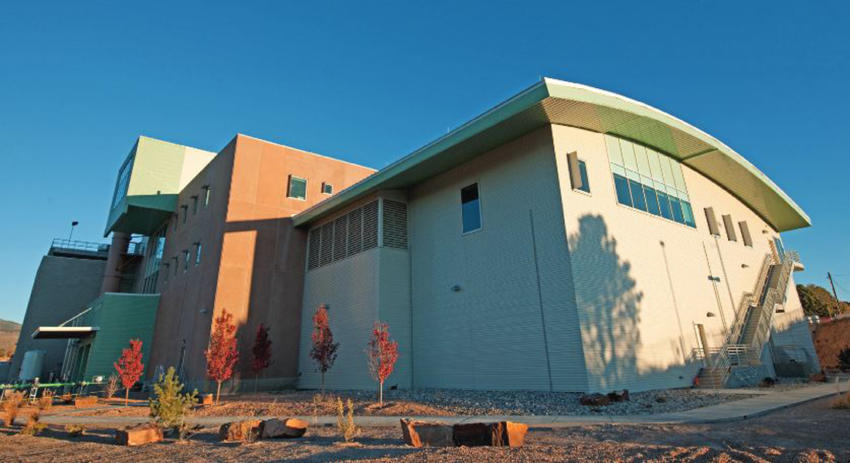
Lisa Gordon-Hagerty, head of the National Nuclear Security Administration (NNSA), has rejected a request by New Mexico Senators Tom Udall and Martin Heinrich to extend the public comment period on expanded plutonium “pit” bomb core production because of the COVID-19 pandemic. In contrast, even in normal times NNSA and its parent Department of Energy routinely ask other government agencies for major time extensions when it comes to cleanup and independent oversight.
The two Senators requested a 45 day comment period extension on behalf of more than 120 organizations and individuals. Before that, Tom Udall and Martin Heinrich were among 24 Senators who asked the Office of Management and Budget to extend all federal public comment periods during the coronavirus national emergency.
“Just as the threat of the new coronavirus must be met by cooperation, common-sense and solidarity among peoples and nations, so must the danger of a nuclear war…
Humankind cannot remain oblivious of this persisting danger to its own survival.” — The Novel Coronavirus and Nuclear Weapons
As with viruses, containment of atomic weapons may be good, but eradication is best. — Sergio Duarte & Ira Helfand

Cleanup of US Nuclear Waste Takes Back Seat as Virus Spreads
ALBUQUERQUE, N.M. (AP) — The U.S. government’s efforts to clean up Cold War-era waste from nuclear research and bomb making at federal sites around the country has lumbered along for decades, often at a pace that watchdogs and other critics say threatens public health and the environment.
Now, fallout from the global coronavirus pandemic is resulting in more challenges as the nation’s only underground repository for nuclear waste finished ramping down operations Wednesday to keep workers safe.

Over more than 20 years, tons of waste have been stashed deep in the salt caverns that make up the southern New Mexico site. Until recently, several shipments a week of special boxes and barrels packed with lab coats, rubber gloves, tools and debris contaminated with plutonium and other radioactive elements were being trucked to the remote facility from South Carolina, Idaho and other spots.
OREPA Accuses NNSA of Mendacity on Nuclear Criticality Safety
A letter dated April 6, 2020 from Lisa Gordon-Hagerty, Administrator of the National Nuclear Security Administration, to Consolidated Nuclear Services, operating contractor of the Pantex and Y-12 nuclear weapons facilities, highlights ongoing criticality safety deficiencies at the Y-12 National Security Complex in Oak Ridge, Tennessee.
The letter, a Preliminary Notice of Violation, characterizes the nuclear criticality safety deficiencies as “of high safety significance.” In the letter, NNSA reveals that CNS has failed to implement the criticality safety plan that was in place when it took over operations at the facility in 2014.
Russia Says Using New U.S. Warheads Would Provoke Nuclear Retaliation
Fires are still blazing near the site of the world’s worst nuclear disaster. Ukraine’s President Volodymyr Zelenskiy has visited firefighters trying to extinguish the flames, marking the 34th anniversary of the accident.
ARTICLE BY: CLYDE HUGHES | upi.com
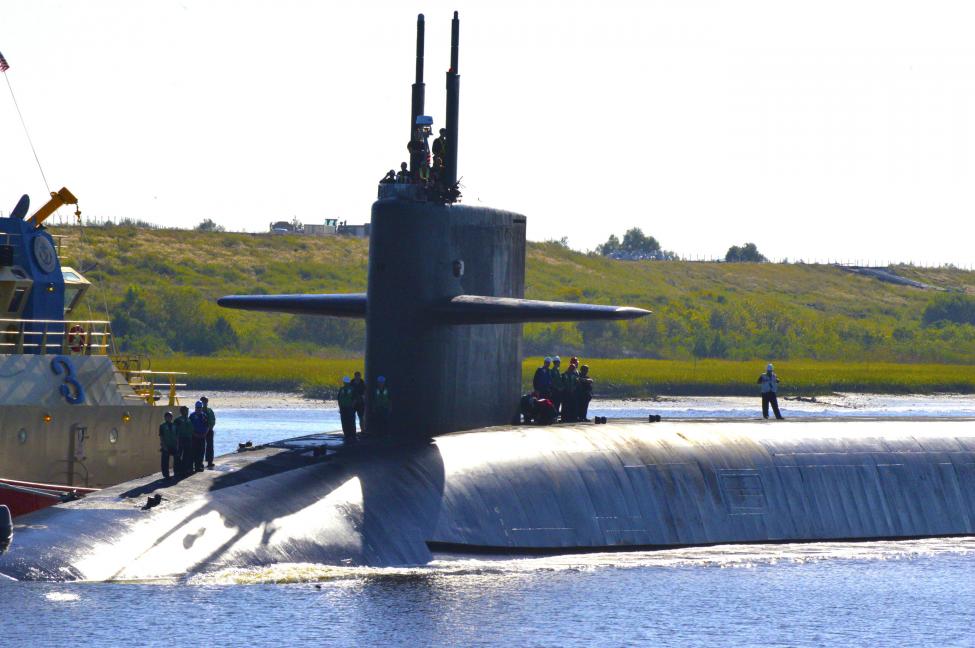
Wednesday, foreign ministry spokeswoman Maria Zakharova cautioned the U.S. military that using those weapons against Russia would warrant a nuclear retaliatory strike.
“Any attack involving a U.S. submarine-launched ballistic missile, regardless of its weapon specifications, would be perceived as a nuclear aggression,” Zakharova said. “Those who like to theorize about the flexibility of American nuclear potential must understand that in line with the Russian military doctrine such actions are seen as warranting retaliatory use of nuclear weapons by Russia.”
The U.S. State Department suggested last week that equipping Navy submarines with the low-yield nukes — which have explosive power similar to the atomic bombs dropped in Japan during World War II — would only serve to deter military provocation from Russia and China.
Defense Budget Brawl Looms After Pandemic
Defense budget cuts are looming as the coronavirus pandemic places pressure on the federal budget across various agencies.
ARTICLE BY: REBECCA KHEEL | thehill.com
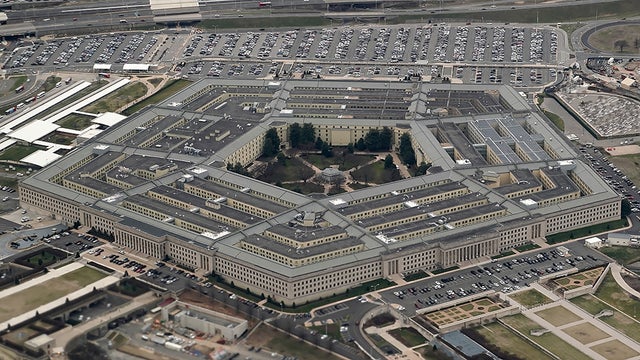
The Pentagon had already been expecting relatively flat budgets for the next few years due to economic constraints caused by the widening deficits in the country.
But with the pandemic, the deficit is projected to explode after Congress passed trillions of dollars in coronavirus relief packages, with more aid bills expected. Defense budget analysts are predicting that will mean cuts to defense spending down the line.
Meanwhile, Democrats say the crisis should result in a rethinking of national security that gives less money to the Pentagon and more to areas like public health.
Agency seeks $8K reimbursement from former executive director
REGIONAL COALITION OF LANL COMMUNITIES
Two years after parting ways with the Regional Coalition of LANL Communities, state Rep. Andrea Romero is still being haunted by improper reimbursements that cast a dark cloud over her tenure as the agency’s executive director.

The board of the taxpayer-funded agency that represents local governments around Los Alamos National Laboratory recently decided to ask Romero to return $8,000 in questionable reimbursements she received for travel and entertainment expenses while she was at the helm of the organization, which occurred before she was elected to a seat in the state House of Representatives.
But the board is unlikely to pursue the matter further if Romero rejects the request.
The board reached its decision to try to recoup the money after receiving a review of past audits of the agency, also known as RCLC, from its contracted legal counsel, Nancy Long.
Fire Licks the Chernobyl Perimeter
Fires are still blazing near the site of the world’s worst nuclear disaster. Ukraine’s President Volodymyr Zelenskiy has visited firefighters trying to extinguish the flames, marking the 34th anniversary of the accident.
ARTICLE BY: CINDY FOLKERS | beyondnuclearinternational.org
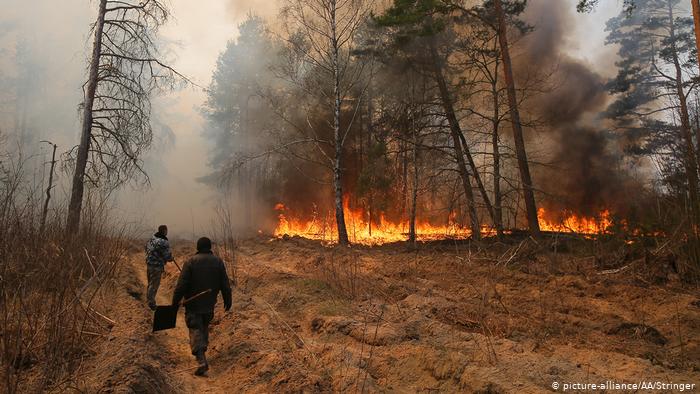
How close to the Chernobyl nuclear plant did the recent forest fires come? Did the smoke that enveloped Kyiv contain dangerous levels of radioactivity? We look at these and other questions about the deadly legacy of the 1986 nuclear disaster.
The recent wildfires in Ukraine and Belarus came dangerously close to the Chernobyl nuclear power plant site. Some burn still; others are smoldering. So, too, are the lingering doubts about denials from the Ukraine government that the fires, which tore through areas of the already radioactive Chernobyl Exclusion Zone, posed no radiological risks to those breathing in their fumes.
Suggested comments are here
We encourage you customize your comments. Please feel free to use as many or all of our words as you like. But the most important thing is to get something in! THANK YOU!
The Trump Administration Is Suddenly Pretending That It Didn’t Blow Up the Iran Nuclear Deal
BY: FRED KAPLAN | slate.com
While everyone is riveted to the deadly grind of COVID-19, the Trump administration is stepping up its efforts to crush the Islamic Republic of Iran through one of the most squirrely legal arguments that a nation-state has ever devised.
The move is also a political shot in the foot, because it amounts to an unwitting admission that President Donald Trump was wrong to pull out of the Iran nuclear deal.
Appeal: New Mexico ignored rules in OK of nuke site work
Susan Montoya Bryan / Associated Press | apnews.com
ALBUQUERQUE, N.M. (AP) — A watchdog group asked the New Mexico Court of Appeals to put the brakes on a key construction project at the nation’s only underground nuclear waste repository.
The Southwest Research and Information Center alleged in court documents that state environmental officials ignored existing regulations, past agency practices and case law when giving temporary approval for contractors to begin building a new ventilation shaft at the Waste Isolation Pilot Plant.
WIPP faces security, space challenges
The experts are recommending the Energy Department conduct an environmental review to consider the full effects of the plan on the repository, which plays a key role in the nation’s multibillion-dollar program to clean up Cold War-era waste from decades of nuclear research and bomb making.
Susan Montoya Bryan / Associated Press | santafenewmexican.com
ALBUQUERQUE — Security and the availability of space at the U.S. government’s only underground nuclear waste repository are among the challenges identified by a group of scientists and other experts tasked by Congress to review the viability of a plan to dispose of tons of weapons-grade plutonium at the desert location.
The National Academies of Sciences, Engineering, and Medicine on Thursday released its final report on the plan, which would cost an estimated $18 billion over three decades to dilute a few dozen metric tons of plutonium and ship it to the Waste Isolation Pilot Plant in southeastern New Mexico.
STALKING CHERNOBYL: exploration after apocalypse (Trailer) from Cultures of Resistance Films on Vimeo.
“A vivid and compelling film… where a dose of adrenaline matters more than a dose of radiation.” — Beyond Nuclear International
“Stalking Chernobyl: Exploration After Apocalypse” (2020) is a fascinating documentary from Cultures of Resistance Films that offers a unique portal into the clandestine culture that has developed around the Chernobyl Exclusion Zone three decades after the world’s worst nuclear disaster.
Defense budget cuts following the pandemic will be hard to swallow
BY: DOV S. ZAKHEIM | thehill.com

Congress has appropriated more than $2.25 trillion to counter the impact of COVID-19 on American families and the economy. It is likely to spend even more once legislators return from their recess in early May. This unprecedented level of expenditure is resulting in a massive deficit and national debt levels that are likely to exceed 120 percent of the nation’s gross domestic product, especially as GDP growth itself is no longer a foregone conclusion. In turn, there will be renewed pressure on the defense budget, which already is forecast to have no real growth in fiscal year 2021.
NNSA lengthens comment period for Savannah River pit production environmental study
BY: COLIN DEMAREST | aikenstandard.com
The National Nuclear Security Administration has extended the period in which it is taking comments and input on its draft review of the environmental impacts of plutonium pit production at the Savannah River Site.
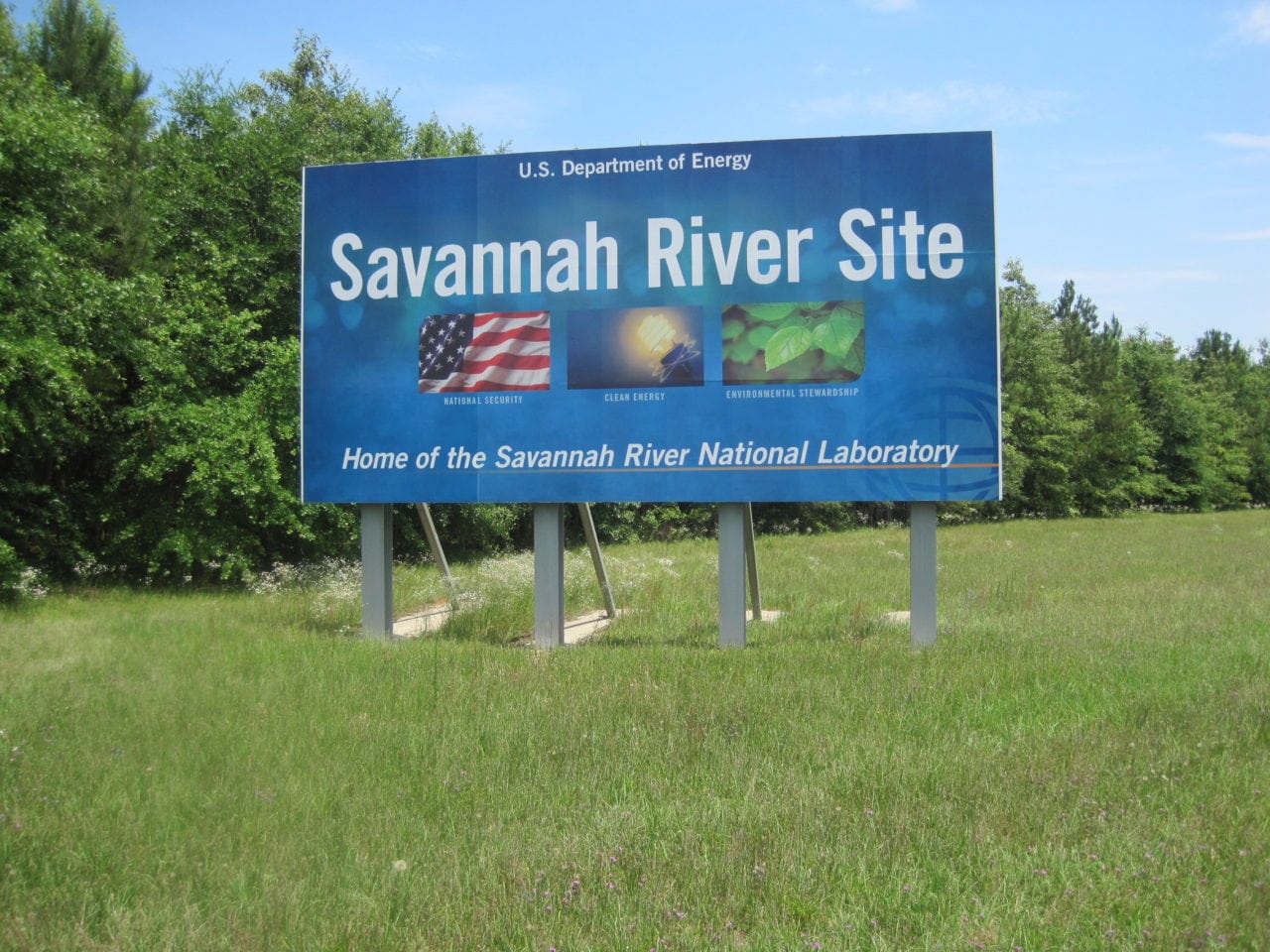
Feedback can now be submitted through June 2. The previous deadline was May 18.
Comments concerning the Savannah River Site plutonium pit production draft environmental impact statement can be emailed, the preferred method, to [email protected]. Comments can also be mailed to Jennifer Nelson, NEPA Document Manager, National Nuclear Security Administration, Savannah River Field Office, P.O. Box A, Aiken, S.C. 29802.
“STALKING CHERNOBYL” Q&A EVENT ON APRIL 26
On Sunday, 26 April 2020 the UN-designated International Chernobyl Disaster Remembrance Day, “Stalking Chernobyl” director Iara Lee hosted a live online Q&A session moderated by Jodie Evans, CODEPINK founder, with:
• Cindy Folkers, Radiation & Health Specialist from Beyond Nuclear International
• Sergii Mirnyi, scientist/tour operator from Chernobyl Tours
• Vitaly Servetnik from Friends of the Earth/Russian Socio-Ecological Union
• “Stalking Chernobyl” editor Dimo Petkov, cameraman Anton Fedorrko, co-producer Oleg Shalashov
• Dominik Orfanus, Yurij Syrcek, and Igor Pasko from the ; Chernobyl Welcome Tour Company
• Vladislav Voznjuck from the stalker/tour group DiggTour
• Lucas Brunelle, extreme cyclist and creator of ” Lucas Brunelle Goes To Chernobyl”
The discussion was livestreamed to Cultures of Resistance’s Facebook page at https://www.facebook.com/CulturesOfResistance/ and YouTube channel at https://www.youtube.com/user/CulturesofResistance
North Korea is advancing its nuclear program and increasing illicit trade, new UN report says
North Korea is advancing its nuclear program and increasing illicit trade in new and more opaque ways, according to a 267-page U.N. report that provides surveillance photos and new evidence.
The annual report, produced by sanctions monitors called the “Panel of Experts,” is a product of the U.N. Security Council. The purpose of the report is to offer recommendations on how to hold North Korea accountable for skirting restrictions imposed by U.N. sanctions since 2006, that are designed to curtail the nation’s nuclear weapons program.
New Mexico’s U.S. senators request more time for comment on LANL pit production
A letter from 120 activist groups and citizens has prompted the state’s two U.S. senators to ask federal agencies to give the public more time to comment on possible environmental effects of pit production at Los Alamos Laboratory.
ARTICLE BY: SCOTT WYLAND | santafenewmexican.com
U.S. Sens. Tom Udall and Martin Heinrich wrote to the National Nuclear Security Administration on Wednesday, urging it to extend the public comment period to June 19 on its environmental study of the lab’s future production.
They cited challenges presented by the COVID-19 crisis and referred to a letter they received from activists who had asked for the June 19 extension.
“We continue to believe that providing the public ample opportunity to comment on environmental documents … provides an invaluable source of expertise to NNSA’s decision-makers, enhances transparency and ensures accountability,” the senators wrote. “We respectfully request that you give careful consideration to extending the public comment period.”
60+ Orgs to Congress: No More COVID-19 Money For the Pentagon
 commondreams.com WASHINGTON – Congressional leadership must ensure that future COVID-19 response bills do not include any additional funds for the Pentagon, 61 organizations representing pro-diplomacy, veteran, faith, environmental, and anti-war communities, and more, from across the country, said in a letter today.
commondreams.com WASHINGTON – Congressional leadership must ensure that future COVID-19 response bills do not include any additional funds for the Pentagon, 61 organizations representing pro-diplomacy, veteran, faith, environmental, and anti-war communities, and more, from across the country, said in a letter today.
The letter, led by Win Without War, states that the Pentagon’s $756 billion budget provides more than enough resources to respond to the crisis caused by the pandemic. While there may be a limited role for the Pentagon in responding to the crisis — by, for example, aiding with construction of hospitals — the letter’s signers agree that these activities should be funded by the already-oversized Pentagon budget.
Letter to NNSA from NM Senators Udall & Heinrich Calling for Extended Comment Period on Expanded Plutonium Pit Production
[embeddoc url=”https://nukewatch.org/wp-content/uploads/2020/04/Senators-letter-to-NNSA-4-22.pdf” download=”all” viewer=”google”]
2019
IG: Embattled coalition should return up to $300K to DOE
ARTICLE BY: T.S. LAST | abqjournal.com
SANTA FE – The U.S. Department of Energy’s inspector general is recommending that the department seek reimbursement of up to $300,000 in DOE grant money that a coalition of local governments in northern New Mexico didn’t properly account for.
“The Regional Coalition is not the effective lobbying voice for clean up at Los Alamos that it claims to be because it condones DOE’s plan for cleanup on the cheap that will leave the vast majority of radioactive and toxic wastes permanently buried above our groundwater,” Jay Coghlan of Nuclear Watch New Mexico said in a statement Wednesday.
“The Coalition should pay the American taxpayer back whatever it improperly spent and be terminated. At a minimum, the City of Santa Fe should resign from this discredited Coalition right away.”
October 1 House Democrats launched an impeachment inquiry against President Donald Trump last week. What does this mean for nuclear policy and national security? Ro Khanna, US Representative from California’s 17th congressional district, joins Joe Cirincione for a special interview on the explosive allegations against the US president and the need to prevent a new war of choice during this time. Rep. Khanna, with Rep. Matt Gaetz (R-FL), introduced a bipartisan amendment to the annual National Defense Authorization Act to prevent federal funds from being used for any military force against Iran without congressional authorization. “In the Silo” provides an exclusive look at the August 6 protest in front of the Lawrence Livermore National Laboratory, featuring narration by Ploughshares Fund Development Associate Elissa Karim.
News summary with Mary Kaszynski, Joe Cirincione, and Abigail Stowe-Thurston of the Center for Arms Control and Non-Proliferation. Joe Cirincione answers a question from Susan in California.
Listen, Subscribe and Share on iTunes · Spotify · SoundCloud · YouTube · Google Play · Sticher
Also available on ploughshares.org/pressthebutton

BY THAD MOORE [email protected]
About this series
This article is the second part in “Lethal Legacy,” The Post and Courier’s investigation into the nation’s plans for disposing of plutonium, the dangerous metal that triggers nuclear weapons. This installment probes the Department of Energy’s failed MOX project, an ambitious but doomed effort to clean up the legacy of the Cold War.
Part I: Why South Carolina is likely stuck with a stockpile of the nation’s most dangerous nuclear materials
Dogged by faulty assumptions and lacking political will, the federal government squandered billions of dollars and an opportunity to dispose of the nation’s most dangerous nuclear material by chasing a massive construction project in South Carolina that was doomed from the start.
The MOX saga reveals an unsettling reality of the nuclear era after the Cold War. The U.S. and the world’s other nuclear powers have proven they are capable of pulling the explosive potential out of atoms, but they have proven unable to dispose of a creation that will retain immense power and be a danger for eternity.
What is MOX? MOX, short for mixed-oxide, is a type of fuel for commercial nuclear reactors. It gets its name from the combination of two oxidized nuclear metals: plutonium and uranium.The U.S. government and Russia agreed to make MOX fuel with highly enriched plutonium, which they made for nuclear weapons during the Cold War. The idea was to make the plutonium less potent and generate electricity by reacting it in power plants; the project’s supporters described it as a way for the countries to turn their “swords into plowshares.”
Nuclear weapons: Explained in numbers
There are far fewer nuclear weapons now than at the height of the Cold War and the major nuclear powers have all signed up to the principle of disarmament. But there are other countries that possess nuclear weapons which have not signed up to any arms control treaties.
And with fears of a renewed nuclear arms race between the US, Russia and China, the topic is high on the agenda at this year’s UN General Assembly. Reality Check’s Jack Goodman takes a look at the facts and figures behind the world’s nuclear arsenals.
Motion graphics by Jacqueline Galvin. | 26 Sep 2019 © bbc.com
“Nuclear weapons present an unacceptable danger to humanity. The only real way to eliminate the threat of nuclear weapons is to eliminate nuclear weapons.”
— UN Secretary-General António Guterres

Is it time to ditch the NPT?
“Nuclear weapon states have used this treaty to argue that their nuclear weapons are legal and a sovereign right. As a result, the NPT became the cornerstone of a severely hypocritical nuclear order where a few states regard wielding their nuclear weapons as legitimate while proscribing this sovereign right to other states…nuclear weapon states have no intention to give up their nuclear weapons.”
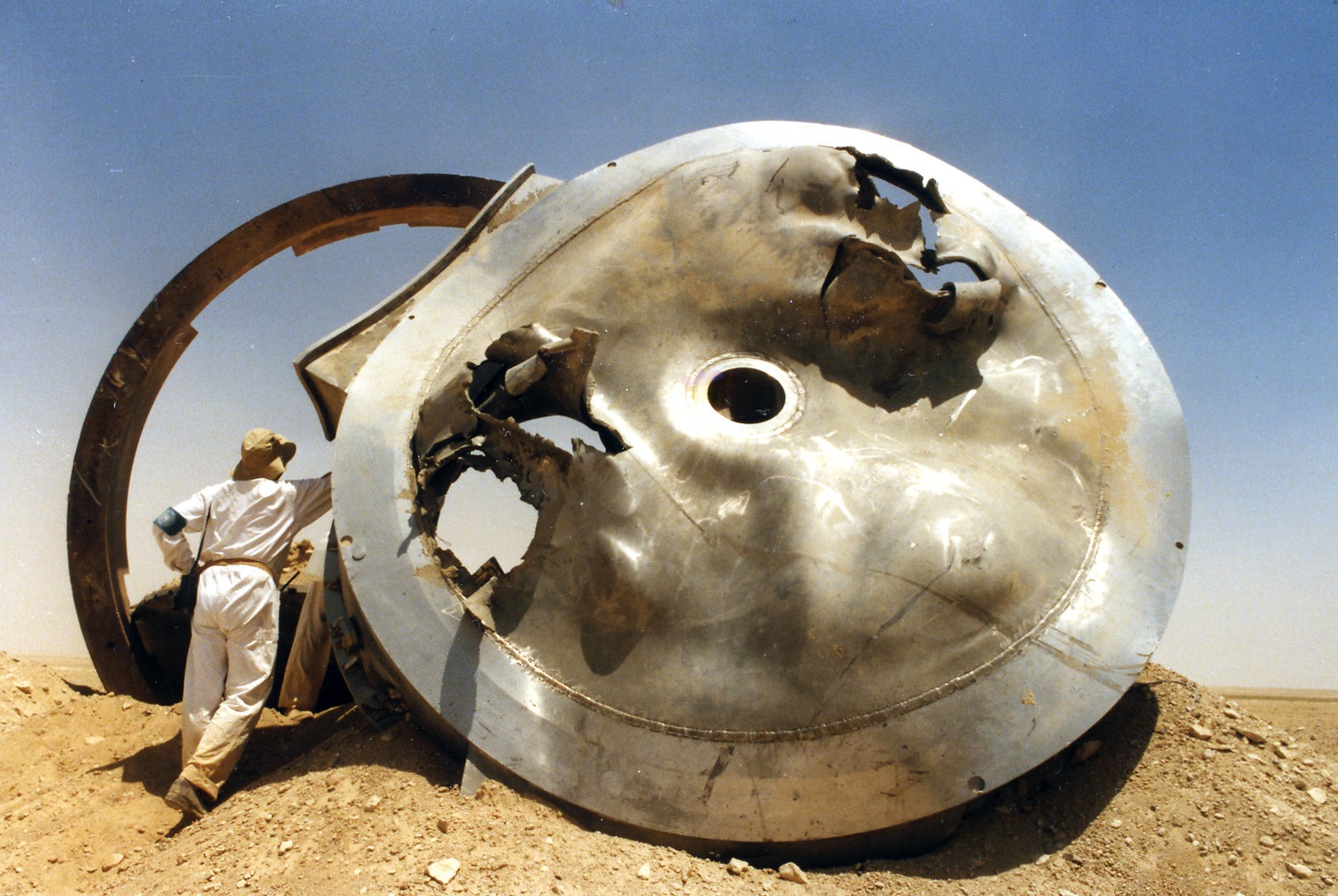
BY JOELIEN PRETORIU & TOM SAUER | thebulletin.org ![]()
In 2020, the participants in the 1970 Treaty on the Non-Proliferation of Nuclear Weapons (NPT) will congregate for the treaty’s 10th review conference. Which means that it may be a good time to re-examine the relevance of the NPT, and even consider the idea of dropping this treaty in its entirety, in favor of the new kid on the block: the 2017 Treaty on the Prohibition of Nuclear Weapons, also know as the Ban Treaty. At the risk of grossly oversimplifying, one treaty seeks to stop the further spread of nuclear weapons, while the other goes further and seeks to get rid of them entirely. This difference is reflected in their formal titles.
New Aerial Photos Released of Trifecta of U.S. Nuclear Construction Debacles
“We are pleased to facilitate distribution of the photos of the three failed nuclear projects in South Carolina and Georgia as close observation of them will reveal the status of the sites and where so much money has been needlessly wasted,” said Tom Clements, Director of Savannah River Site Watch (SRS Watch). “It is stunning to realize that perhaps $40 billion has been spent so far on the three sites, with the cost at all of them going up daily, money that should have been spent on projects of positive benefit to the public,” added Clements. “The photos commemorate the three largest, failed nuclear construction projects in the United States and will be of use when the proper investigations into the failed projects are conducted,” added Clements.
How a $5 part used to modernize nuclear warheads could cost $850 million to fix
World’s first nuclear smart bomb to become even more expensive..
BY AARON MEHTA | defensenews.com
WASHINGTON — Issues with commercial parts on two nuclear warhead modernization projects could cost up to $850 million to fix, but the agency in charge of America’s warheads believes it has a solution.
The issue, first revealed by Verdon during the Sept. 4 Defense News Conference, would put both warhead modernization programs at an 18- to 20-month delay of their first production units, although NNSA is hopeful there won’t be significant delays on the overall program timelines.
The parts in question are commercially available capacitors that, during stress testing, did not give NNSA confidence they could survive the 20-30 years needed for these designs. Verdon stressed that the parts were not at risk of failure under normal circumstances, but that the agency was acting out of an abundance of caution for the long-term life of the weapons.
That caution is pricey: the Original capacitors, Verdon said, ran about $5 per unit. The upgraded ones, built to a higher standard NNSA believes can survive the lifetime of the programs, come in at $75 per unit. All told, the B61-12 will cost an extra $600-700 million, and the W88 will cost about $120-$150 million because of the capacitor issue.
Federal Court Vacates former Y-12 Bomb Plant Ruling
ARTICLE FROM HUNGTINGTON NEWS huntingtonnews.net
“With this ruling,” said Ralph Hutchison, coordinator of the Oak Ridge Environmental Peace Alliance, “the NNSA no longer has any legal authority to continue construction of the Uranium Processing Facility bomb plant.” The decision may have ramifications for NNSA’s efforts to expand nuclear weapons production at other sites, too, including Los Alamos, NM and Savannah River, SC, where environmental scoping is underway for a new plutonium pit manufacturing facility.
Jay Coghlan, director of co-plaintiff Nuclear Watch New Mexico, said, “Uranium and plutonium components manufacturing are two sides of the same coin of expanding nuclear weapons production in an escalating arms race. The Department of Energy should take this court ruling against its Uranium Processing Facility as a warning that it must also comply with National Environmental Policy Act requirements while ill-advisably expanding the production of plutonium pits, the radioactive cores of nuclear weapons.”
The ruling also points out the crucial role the Defense Nuclear Facilities Safety Board plays in monitoring safety issues at Y-12 and across the nuclear weapons complex. Since last year, the Department of Energy has worked to reduce the Safety Board’s access to some nuclear facilities, even issuing a revised Order to limit the information available to the Board and the restricting who the Board can and cannot speak to directly.
Help Stop Plans to “Modernize” WIPP
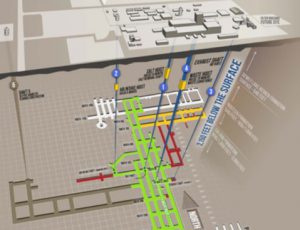
The Waste Isolation Pilot Plant (WIPP), located outside Carlsbad, NM. is the nation’s only geologic repository for defense-generated transuranic waste. The Department of Energy (DOE) is accepting comments on its 2019-2024 “Strategic Plan”, which should be focused on closing WIPP. But the Plan focuses on extending WIPP’s lifetime to 2050 and beyond. WIPP’s disposal phase was extended until 2024 (in 2010), and the last expected year of final closure of the WIPP facility (i.e., date of final closure certification) was to be 2034. There was always a 10-year period for final closure after the disposal operations ceased.
But, instead, the WIPP Strategic Plan is stocked full of new projects that will extend WIPP’s life another 25 years at least. Yet, WIPP officials don’t mention how or when they plan to modify the State Permit with the new proposed date. DOE’s own waste-handling inefficiencies and mistakes have caused this delay that the people of New Mexico are now paying for by having WIPP open longer than planned. We are asking everyone to oppose DOE’s “WIPP Forever” plans by sending in comments. See below.
2018
Clean Up Area G: Hundreds of Jobs Could Be Created that Protect the Environment
Summary
New Mexicans should push their politicians to vigorously lobby for comprehensive cleanup at the Los Alamos National Laboratory (LANL). Unlike nuclear weapons programs, cleanup would be a win-win that permanently protects the environment while creating hundreds of high paying jobs. Continue reading
List of LANL Consent Order Extensions
This is the list of extensions to requirements of the Consent Order requested by LANL and approved or denied by the NM Environment Department.
Framework Agreement
The agreement of the Department of Energy/National Nuclear Security Administration (DOE/NNSA) and the New Mexico Environment Department (NMED) to address the highest risk above-ground transuranic waste currently in Technical Area 54 at LANL.
2016 Revised Consent Order
This revised Consent Order will create serious barriers to achieving cleanup, limits public participation opportunities, undermines enforceability by the Environment Department, puts the Department of Energy (DOE) in the driver’s seat, and lacks a final milestone compliance date. The 2016 Consent Order is potentially a giant step backward in achieving genuine, comprehensive cleanup at LANL.
Arjun Makhijani, President for the Institute for Energy and Environmental Research
Nuclear weapons production and testing have involved extensive health and environmental damage. A remarkable feature of this has been the readiness of governments to harm the very people they claimed to be protecting in building these weapons. Secrecy, fabrication of data, cover-ups in the face of attempted public inquiry… have all occurred in nuclear weapons production and testing programs
-Arjun Makhijani, President, Institute for Energy and Environmental Research.
Project on Government Oversight
“If you really want a future world free of nuclear weapons, you can hardly make a better investment than to give to Nuclear Watch New Mexico. They need and deserve your support so that they can carry on their groundbreaking work. I urge you to be generous with them!” – Danielle Brian, Executive Director, Project on Government Oversight.
Federal District Court Allows Lawsuit to Proceed Against DOE/LANS Potential Penalties Exceed $300,000,000
For Immediate Release
New Mexico Environmental Law Center
Nuclear Watch New Mexico – Santa Fe, NM
A United States District Court judge has ruled that a lawsuit filed by Nuclear Watch New Mexico (NukeWatch) can move forward. The lawsuit is based on thirteen (13) violations of corrective actions Los Alamos National Security, LLC (LANS) and the Department of Energy (DOE) failed to complete under a 2005 Consent Order governing cleanup that the New Mexico Environment Department (NMED) fought for under former Governor Bill Richardson.
Fines for failure to complete the corrective tasks are $37,000 per violation per day. Violations for failing to complete the tasks started as early as June 2014 and now total well over $300 million.
The judge in allowing the lawsuit on civil penalties to move forward stated that DOE/LANS had failed to show in their legal and factual analysis that violations were unlikely to recur.
Jon Block, representing NukeWatch as a staff attorney at the New Mexico Environmental Law Center, said “We are gratified that the Court is allowing the lawsuit on civil penalties to move forward.”
In 2002, the NMED determined that decades of contamination at Los Alamos National Laboratory constituted an “imminent and substantial endangerment to health and the environment” and sought to compel cleanup at the Lab. DOE/LANS counter-sued, and in 2005 the parties agreed to a Consent Order specifying that DOE/LANS would characterize the extent and nature of the contamination, assess alternatives for effective cleanup of the contamination, and implement cleanup. Gov. Martinez came into office in 2011, after which DOE/LANS compliance with the Consent Order effectively stopped.
NukeWatch filed its original complaint in May 2016, followed by an amended complaint in July 2016. That was in response to a June 2016 announcement by NMED and DOE/LANS that they had entered into a new Consent Order that rendered the 2005 Consent Order invalid.
The judge did grant DOE/LANS and NMED’s motions to dismiss that part of NukeWatch’s complaint asking for declaratory and injunctive relief (in general seeking to have the 2016 Consent Order declared invalid). However, the judge specifically noted that the revised 2016 Consent Order replaced enforceable goals in the 2005 Order with unenforceable goals.
Jay Coghlan, NukeWatch director, commented “Susana Martinez’ administration shamefully gave away the store to the Los Alamos Lab, forgiving hundreds of millions of dollars in potential penalties for clear violations of an enforceable cleanup order, at the very time when New Mexico was facing a serious budget crisis. We are very pleased that the issue of penalties can now go forward in court, which should bring some accountability toward achieving comprehensive Lab cleanup that would produce hundreds of high-paying jobs.”
See NukeWatch’s Amended Complaint here
See Judge Judith Herrera’s decision here
Contacts:
Jay Coghlan: Nuclear Watch New Mexico
989.7342
Jon Block, Staff Attorney: New Mexico Environmental Law Center
505.989.9022
2017
Nothing Found
It seems we can’t find what you’re looking for. Perhaps searching can help.
2016
Nothing Found
It seems we can’t find what you’re looking for. Perhaps searching can help.
2015
Nothing Found
It seems we can’t find what you’re looking for. Perhaps searching can help.

